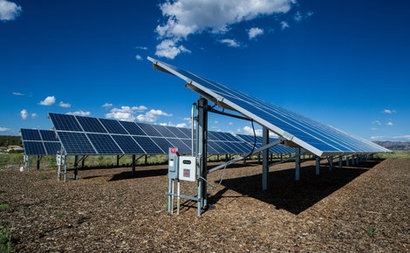
At midday, solar generation reached a peak of 7.77 GW - about six times more than the 1.36 GW capacity of the UK’s largest nuclear power station, Heysham 2 in Lancashire.
Over 24 hours, solar provided an estimated 66.9 gigawatt-hours, or 8.6 percent of the UK’s power needs. About 9 percent of the UK’s electricity was supplied from solar panels over the past seven days.
The generation data comes from Sheffield Solar’s PV Live website. Its modelling was updated yesterday, following the disclosure of new quarterly solar deployment data last week.
“This is climate change, this is happening, this is not a drill” said Chris Hewett, chief executive of Solar Energy UK, reflecting on the scorching conditions. “We have the next decade to accelerate the renewables sector. What’s good news now is that solar and wind are the most affordable way to generate electricity in the UK. We have the solutions to the energy security crisis.”
The efficiency of crystalline silicon solar panels is affected by temperature, though not to a great degree. Rising temperatures from climate change do not jeopardise the UK’s burgeoning solar industry at all.
“It’s marginally better for efficiency in the spring but essentially, if you have more light, you produce more solar power” Mr Hewett added. “You have to remember that solar panels work all over the world. The same technology we put on our roofs is used in solar farms in the Saudi Arabian desert.”
Optimum output from the solar capacity deployed across the UK is reached at around at 25°C. For every degree either side of that, it is lowered by about only 0.5 percent, though newer modules have improved performance. Their output now varies by only around 0.35 percent per degree, according to manufacturers.
“That's why we never see peak output in midsummer - peak national output is always in April and May when it’s cool and sunny” added Sheffield University Professor of Organic Electronics Alastair Buckley, who leads Sheffield Solar.
Panel temperatures depend on a combination of the ambient temperature, radiative heating from the sun and the cooling effect of the wind. Losing 20 percent efficiency, considered a significant amount, would require them to reach a huge 65°C.
Solar power is far from unique in being affected by the heat. The output of fossil-fuelled and nuclear power stations is also hit by heatwaves, as their efficiency depends on the difference between the temperature of their turbines or boilers and their cooling systems.
The revised Sheffield Solar data indicate that record solar generation was reached at midday on 22 April last year, hitting 10.4 GW, replacing the former record of 9.68 GW at 12.30pm on 20 April 2020. A new record is expected next spring due to the fast pace of new installations.
For additional information:

